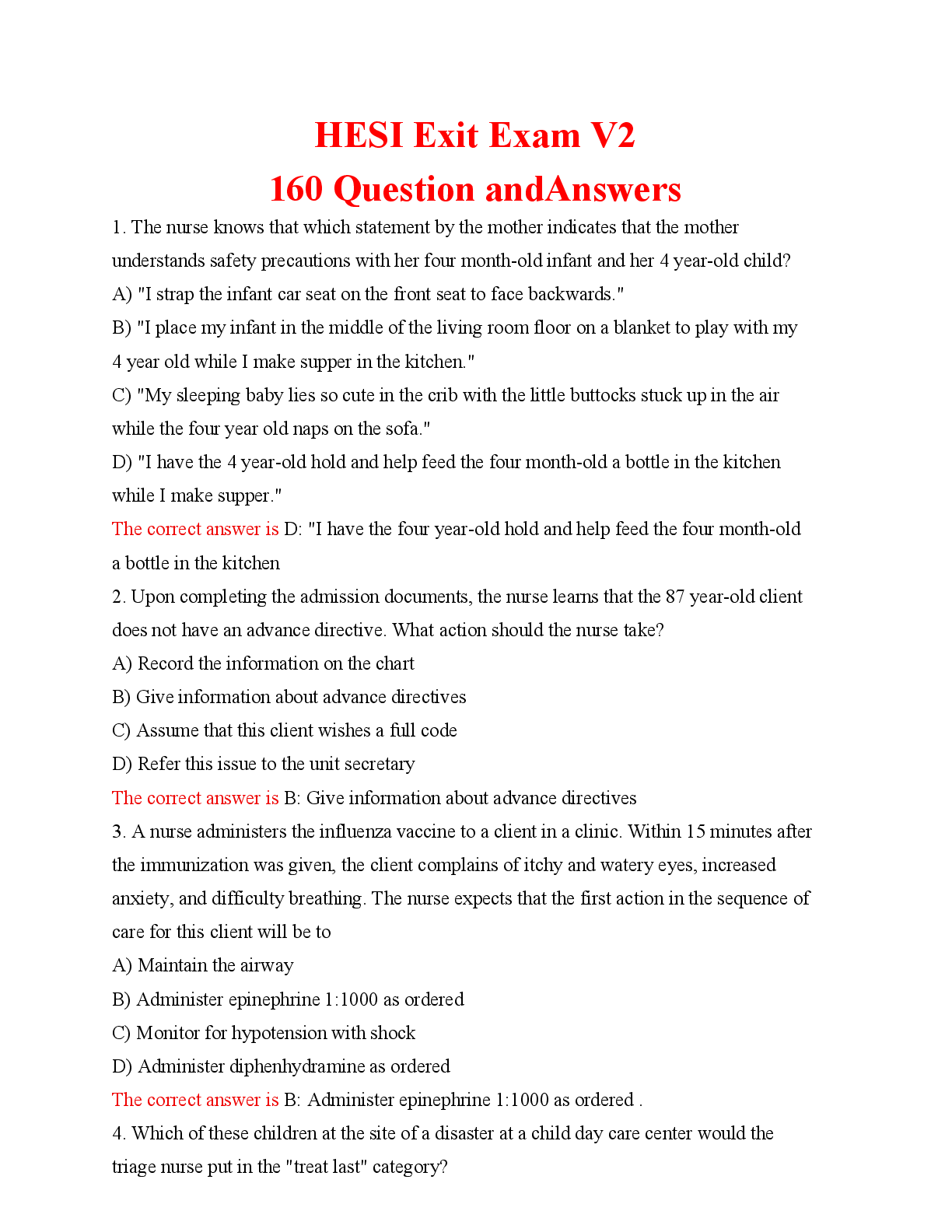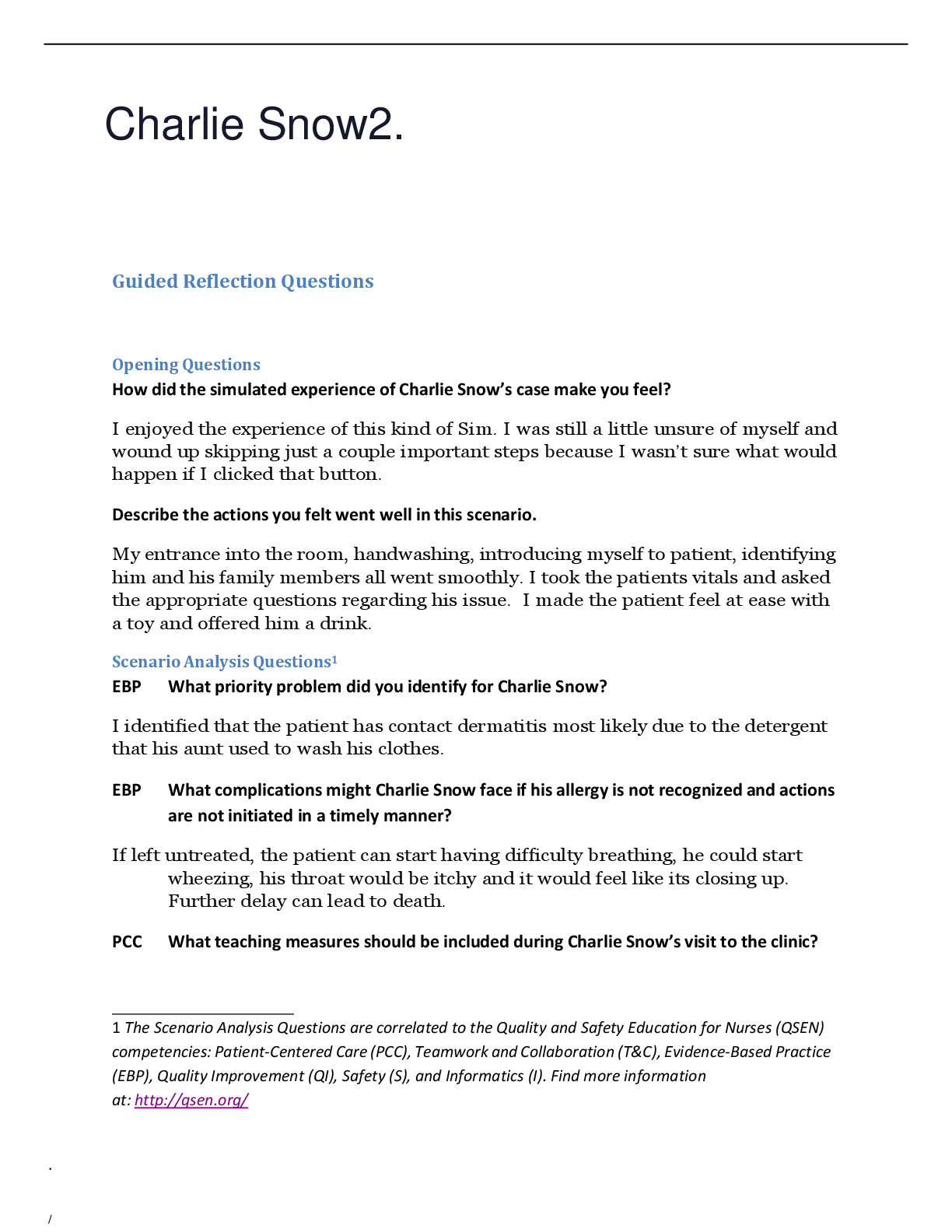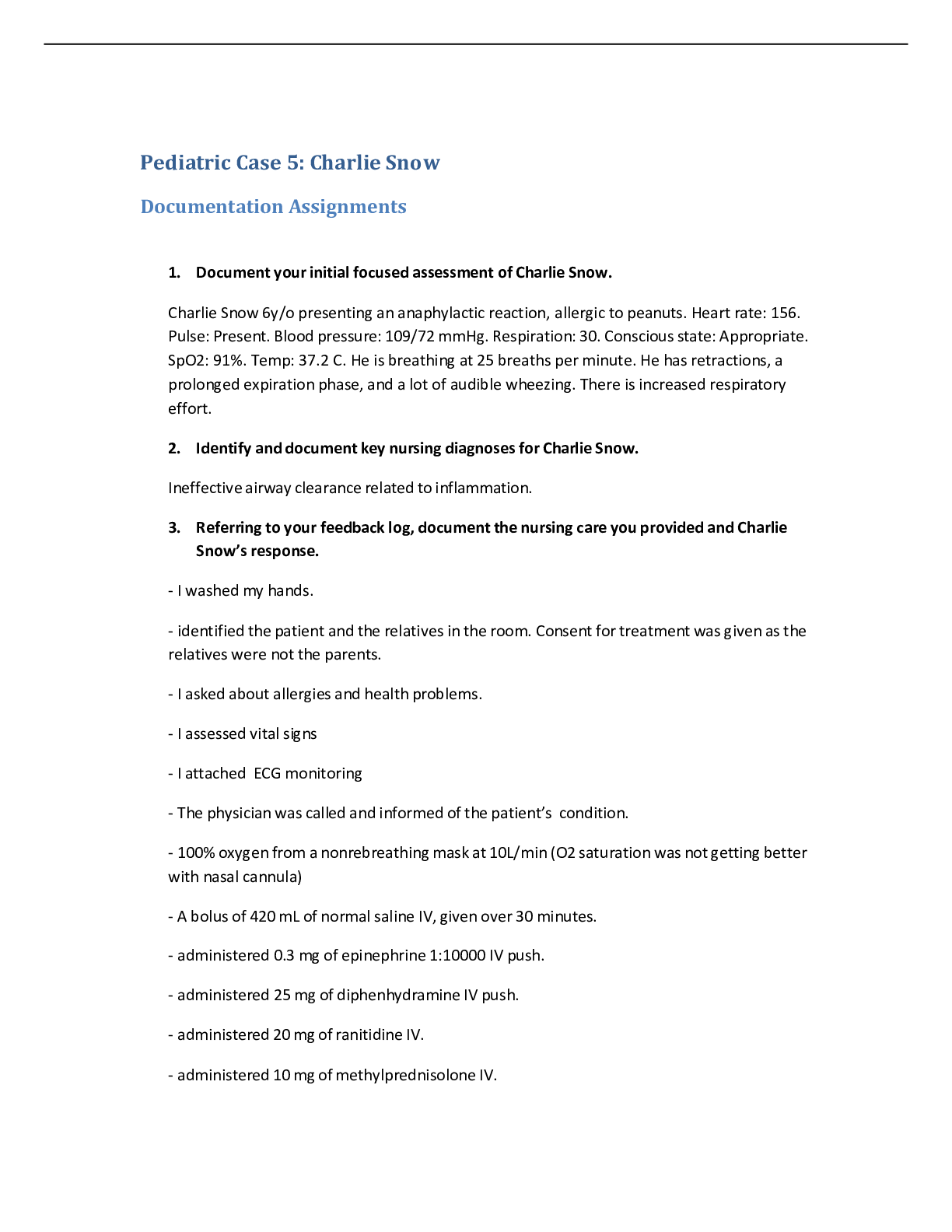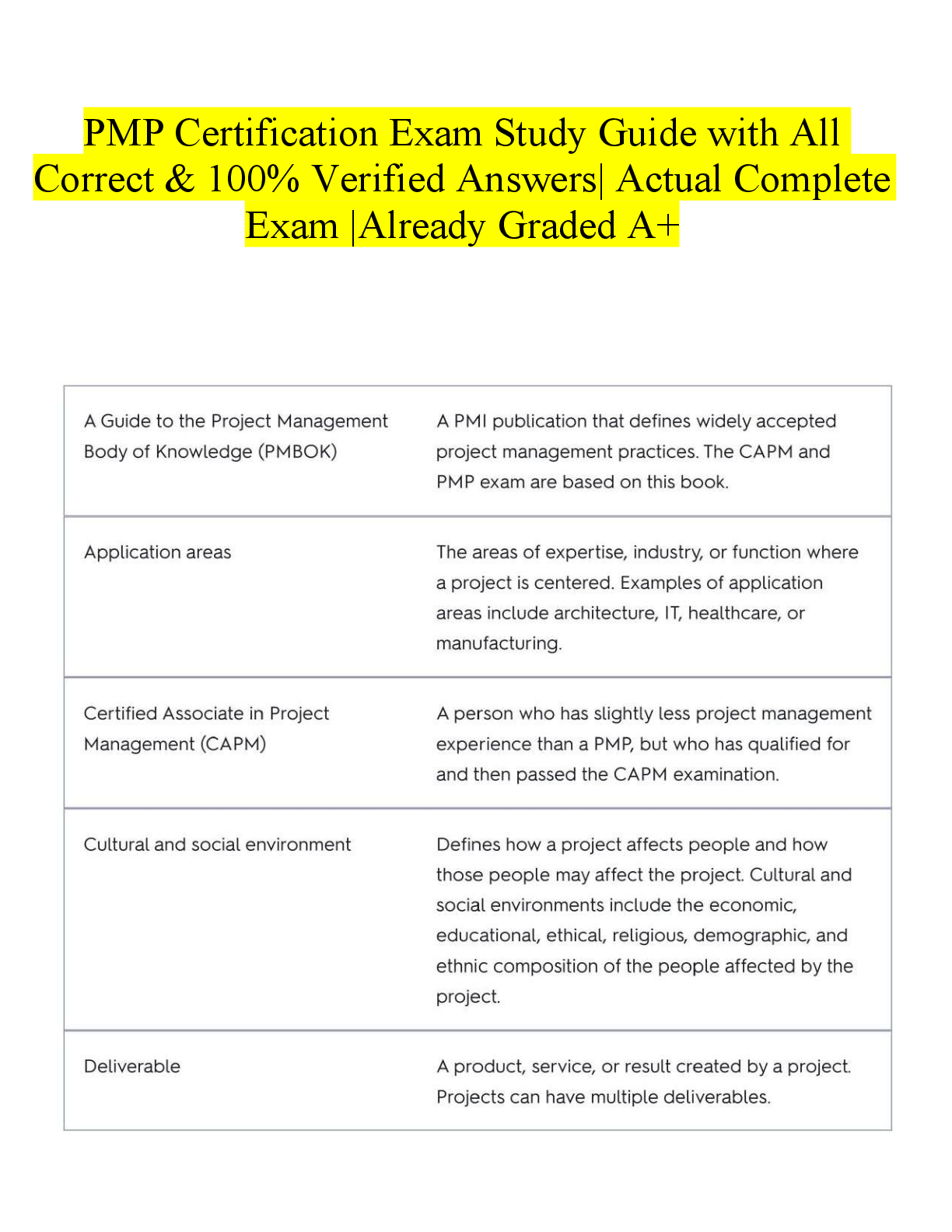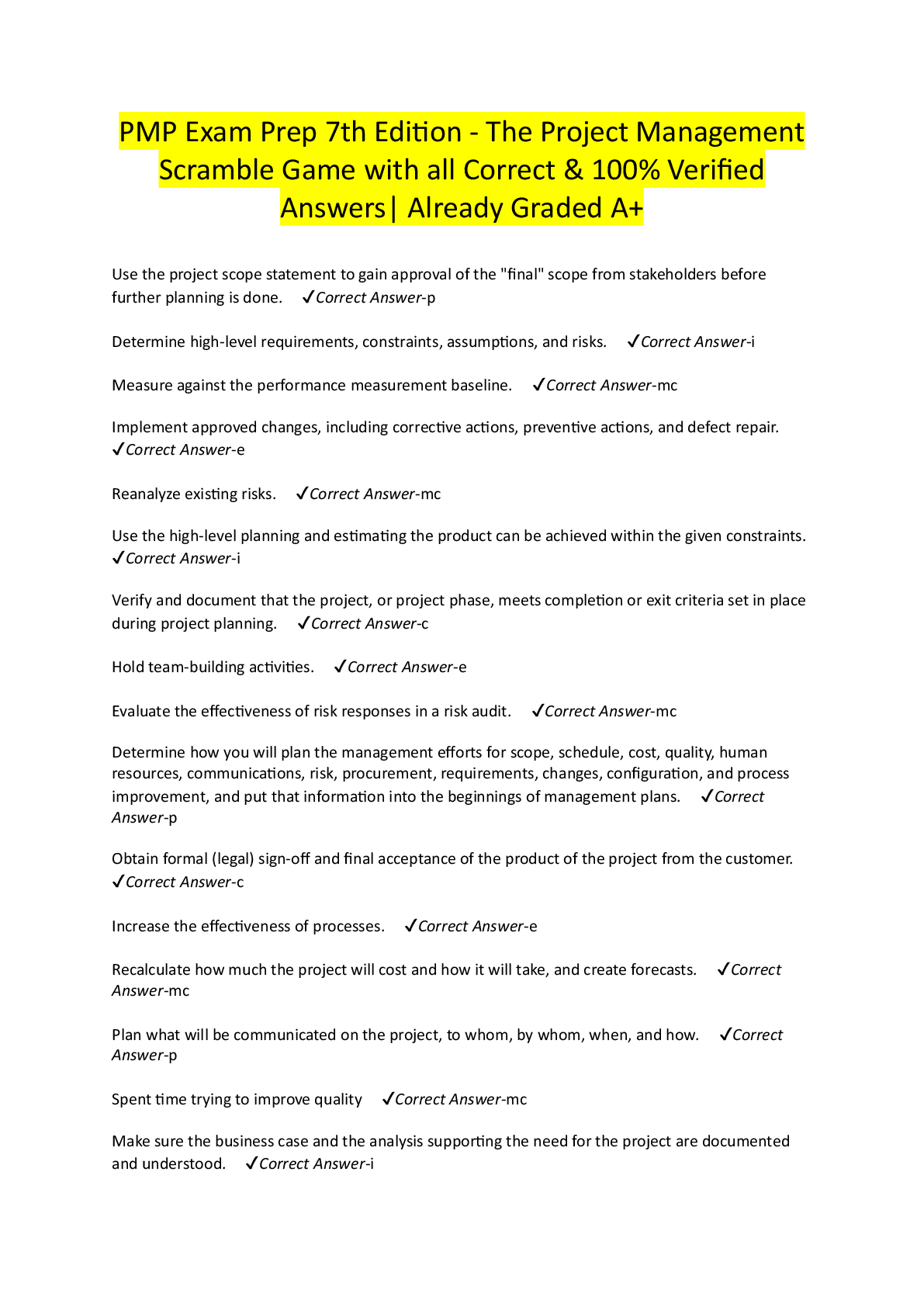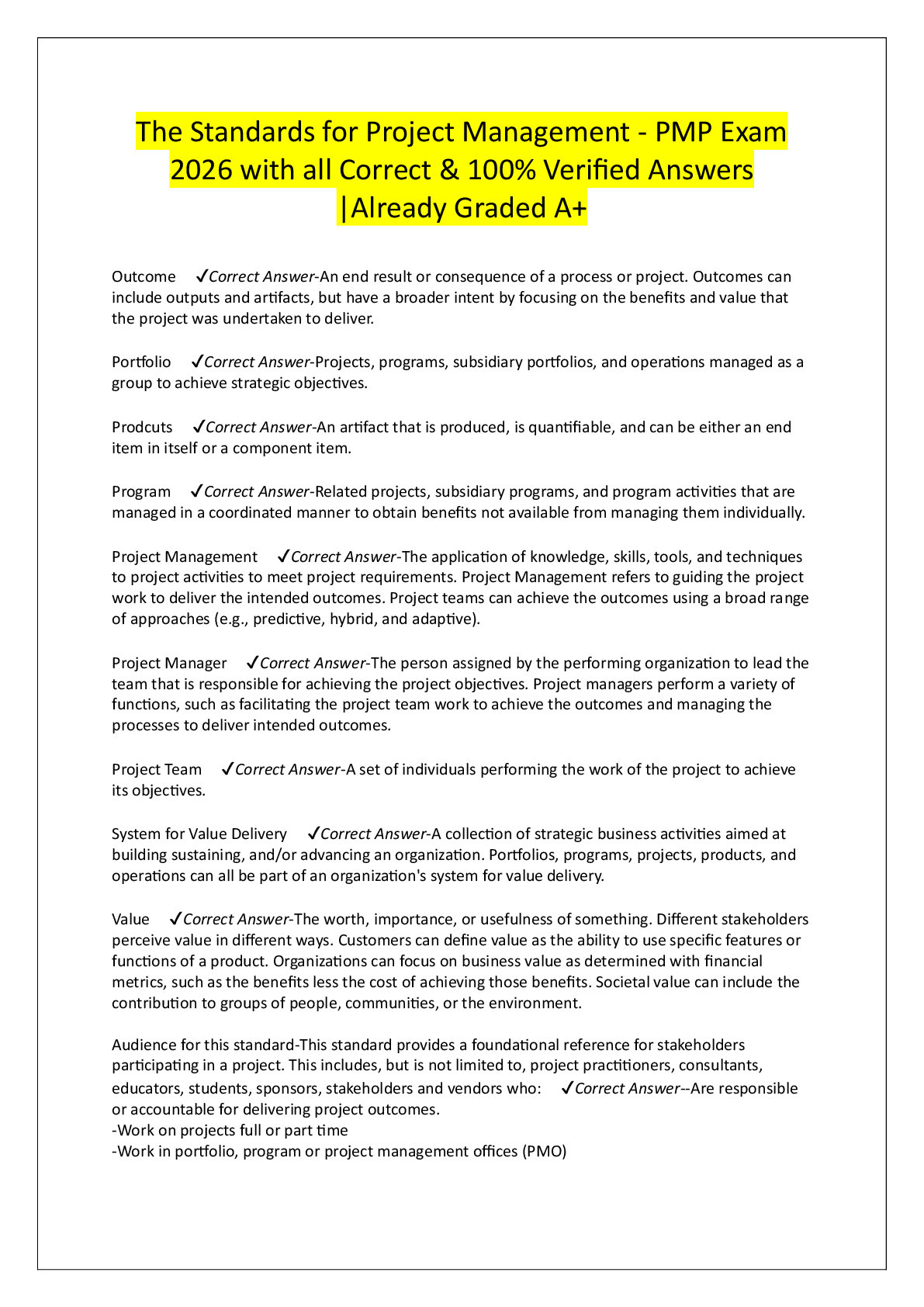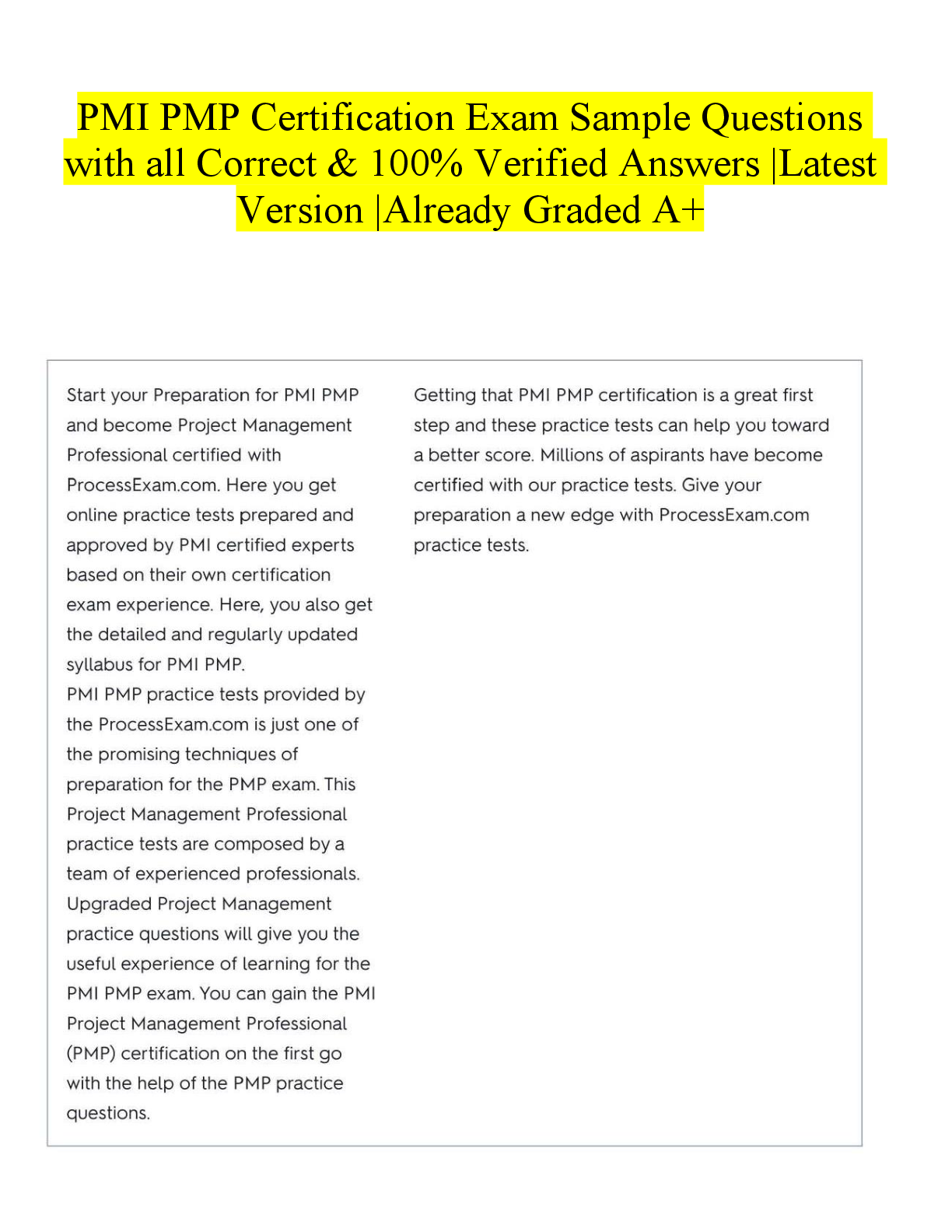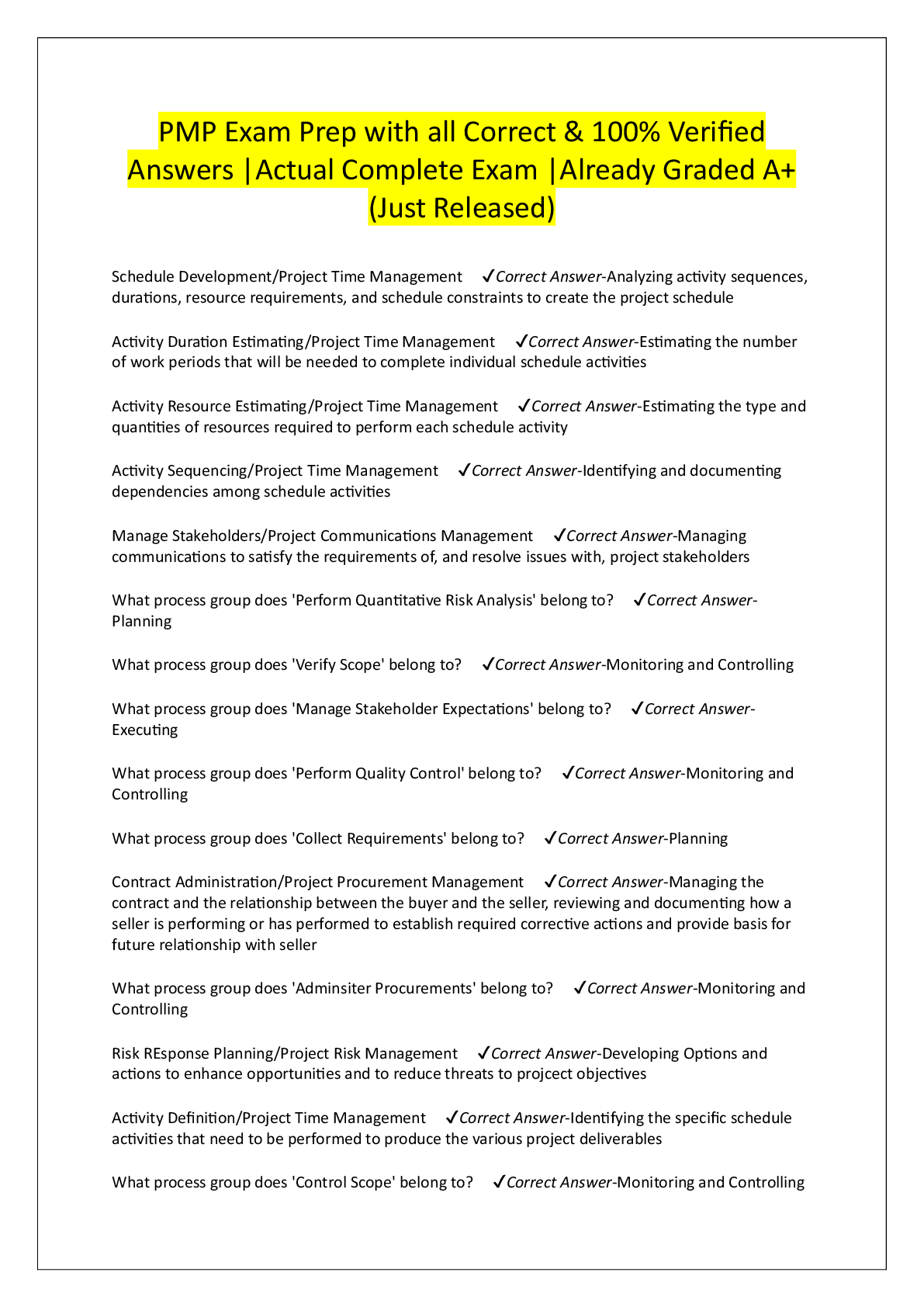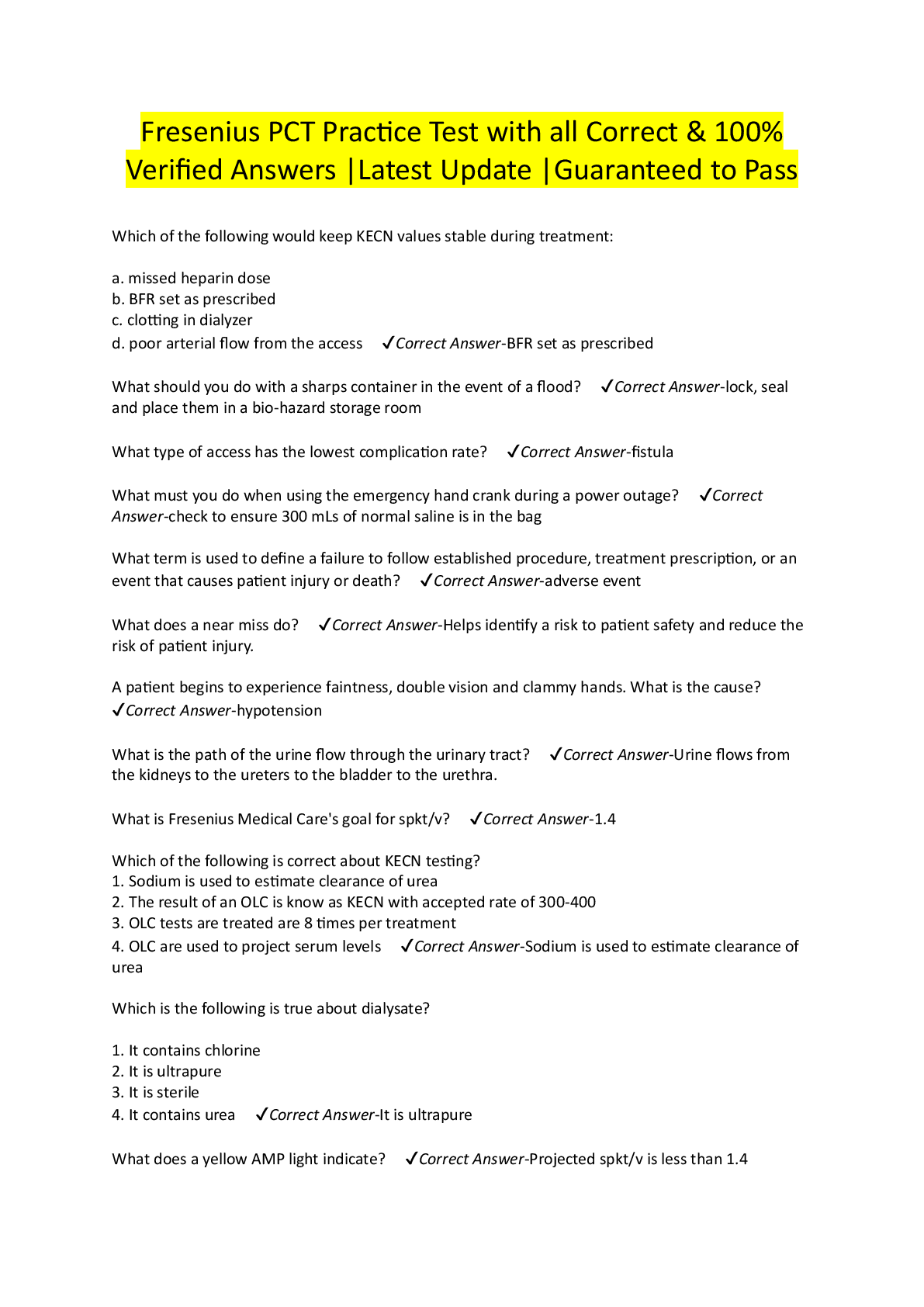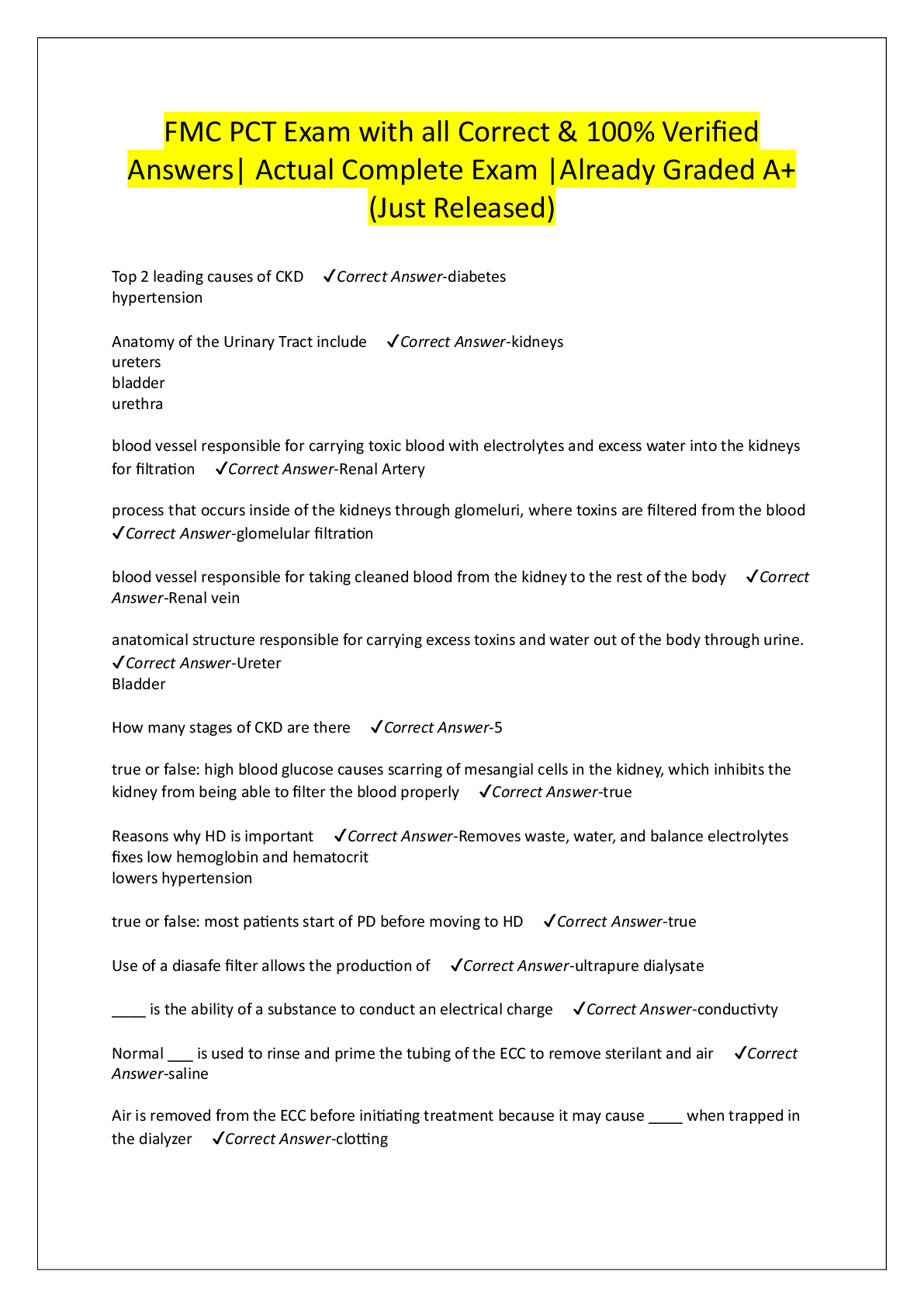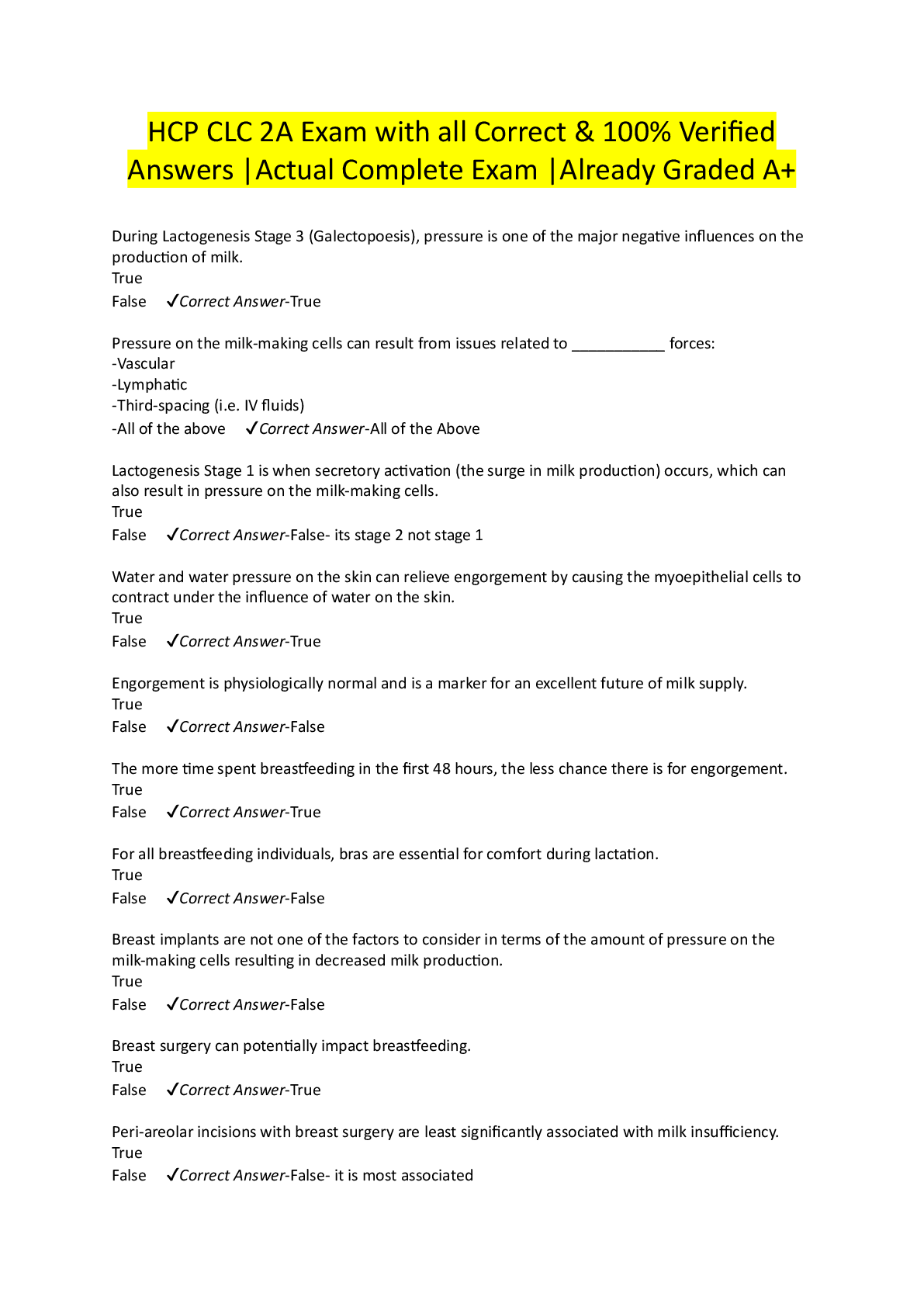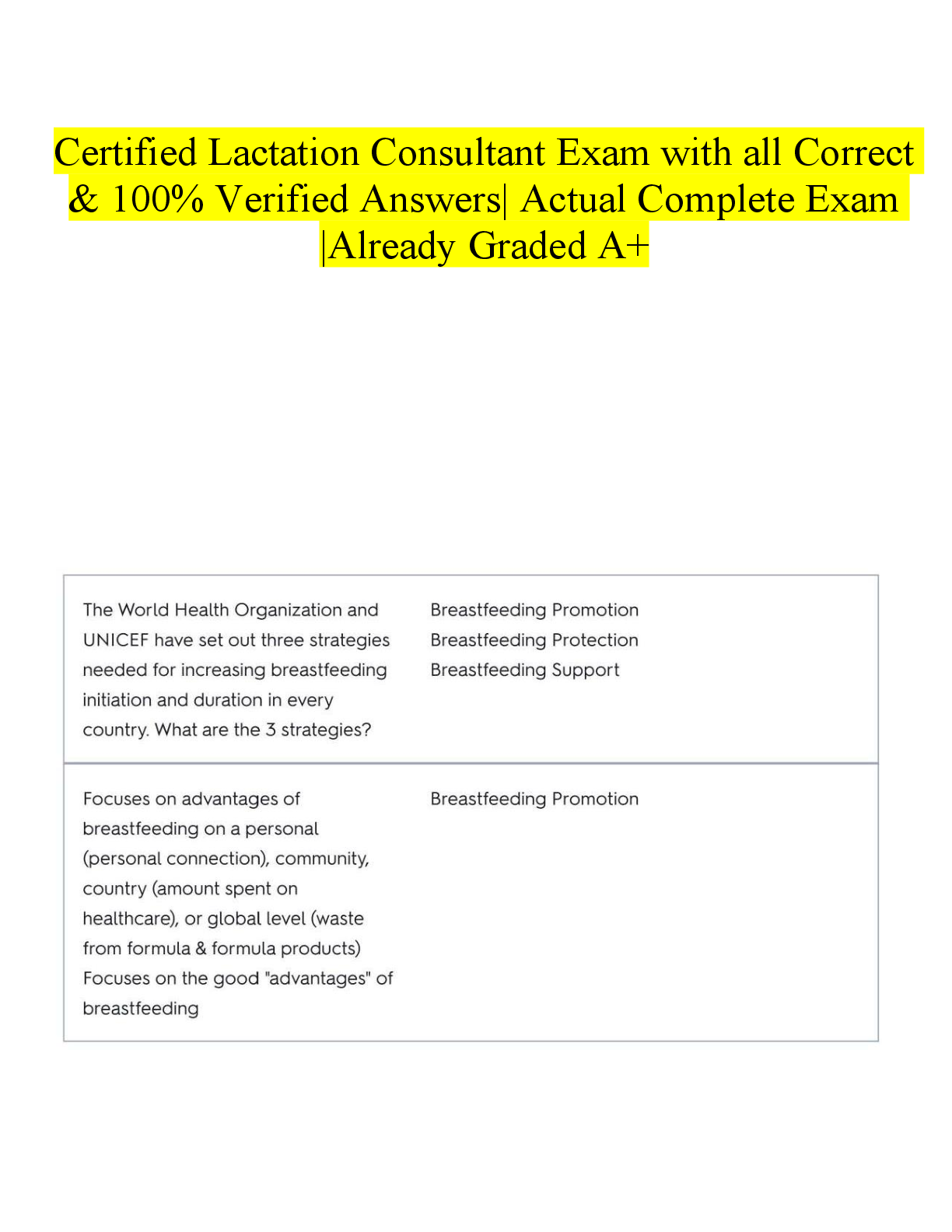HESI Mental Exam 7 Questions & Answers Graded A.
Document Content and Description Below
MENTAL HESI 7 Questions & Answers Practice exam 1. A 30-year-old sales manager tells the nurse, "I am thinking about a job change. I don't feel like I am living up to my potential." Which of Maslow's ... developmental stages is the sales manager attempting to achieve? A. Self-Actualization. Correct B. Loving and Belonging. C. Basic Needs. D. Safety and Security. Self-actualization is the highest level of Maslow's development stages, which is an attempt to fulfill one's full potential (C). (B) is identifying support systems. (C) is the first level of Maslow's developmental stages and is the foundation upon which higher needs rest. Individuals who feel safe and secure (D) in their environment perceive themselves as having physical safety and lack fear of harm. 2. The nurse observes a client who is admitted to the mental health unit and identifies that the client is talking continuously, using words that rhyme but that have no context or relationship with one topic to the next in the conversation. This client's behavior and thought processes are consistent with which syndrome? A. Dementia. B. Depression. C. Schizophrenia. Correct D. Chronic brain syndrome. The client is demonstrating symptoms of schizophrenia (C), such as disorganized speech that may include word salad (communication that includes both real and imaginary words in no logical order), incoherent speech, and clanging (rhyming). Dementia (A) is a global impairment of intellectual (cognitive) functions that may be progressive, such as Alzheimer's or organic brain syndrome (D). Depression (C) is typified by psychomotor retardation, and the client appears to be slowed down in movement, in speech, and would appear listless and disheveled. 3. A homeless person who is in the manic phase of bipolar disorder is admitted to the mental health unit. Which laboratory finding obtained on admission is most important for the nurse to report to the healthcare provider? A. Decreased thyroid stimulating hormone level. Correct B. Elevated liver function profile. C. Increased white blood cell count. D. Decreased hematocrit and hemoglobin levels. Hyperthyroidism causes an increased level of serum thyroid hormones (T3 and T4), which inhibit the release of TSH (A), so the client's manic behavior may be related to an endocrine disorder. (B, C, and D) are abnormal findings that are commonly found in the homeless population because of poor sanitation, poor nutrition, and the prevalence of substance abuse. 4. An adult male client who was admitted to the mental health unit yesterday tells the nurse that microchips were planted in his head for military surveillance of his every move. Which response is best for the nurse to provide? A. You are in the hospital, and I am the nurse caring for you. B. It must be difficult for you to control your anxious feelings. C. Go to occupational therapy and start a project. Correct D. You are not in a war area now; this is the United States. Delusions often generate fear and isolation, so the nurse should help the client participate in activities that avoid focusing on the false belief and encourage interaction with others (C). Delusions are often well-fixed, and though (A) reinforces reality, it is argumentative and dismisses the client's fears. It is often difficult for the client to recognize the relationship between delusions and anxiety (B), and the nurse should reassure the client that he is in a safe place. Dismissing delusional thinking (D) is unrealistic because neurochemical imbalances that cause positive symptoms of schizophrenia require antipsychotic drug therapy. 5. The nurse is assessing a client's intelligence. Which factor should the nurse remember during this part of the mental status exam? A. Acute psychiatric illnesses impair intelligence. B. Intelligence is influenced by social and cultural beliefs. Correct C. Poor concentration skills suggests limited intelligence. D. The inability to think abstractly indicates limited intelligence. Social and cultural beliefs (B) have significant impact on intelligence. Chronic psychiatric illness may impair intelligence (A), especially if it remains untreated. Limited concentration does not suggest limited intelligence (C). Difficulties with abstractions are suggestive of psychotic thinking (D), not limited intelligence. 6. At a support meeting of parents of a teenager with polysubstance dependency, a parent states, "Each time my son tries to quit taking drugs, he gets so depressed that I'm afraid he will commit suicide." The nurse's response should be based on which information? A. Addiction is a chronic, incurable disease. B. Tolerance to the effects of drugs causes feelings of depression. C. Feelings of depression frequently lead to drug abuse and addiction. D. Careful monitoring should be provided during withdrawal from the drugs. Correct The priority is to teach the parents that their son will need monitoring and support during withdrawal (D) to ensure that he does not attempt suicide. Although (A and C) are true, they are not as relevant to the parent's expressed concern. There is no information to support (B). 7. The wife of a male client recently diagnosed with schizophrenia asks the nurse, "What exactly is schizophrenia? Is my husband all right?" Which response is best for the nurse to provide to this family member? A. It sounds like you're worried about your husband. Let's sit down and talk. B. It is a chemical imbalance in the brain that causes disorganized thinking. Correct C. Your husband will be just fine if he takes his medications regularly. D. I think you should talk to your husband's psychologist about this question. The nurse should answer the client's question with factual information and explain that schizophrenia is a chemical imbalance in the brain (B). (A) is a therapeutic response but does not answer the question, and may be an appropriate response after the nurse answers the question asked. Although (C) is likely true to some degree, it is also true that some clients continue to have disorganized thinking even with antipsychotic medications. Referring the spouse to the psychologist (D) is avoiding the issue; the nurse can and should answer the question. 8. A young adult male client, diagnosed with paranoid schizophrenia, believes that world is trying poison him. What intervention should the nurse include in this client's plan of care? A. Remind the client that his suspicions are not true. B. Ask one nurse to spend time with the client daily. Correct C. Encourage the client to participate in group activities. D. Assign the client to a room closest to the activity room. A client with paranoid schizophrenia has difficulty with trust and developing a trusting relationship with one nurse (B) is likely to be therapeutic for this client. (A) is argumentative. Stress increases anxiety, and anxiety increases paranoid ideation; (C) would be too stressful and anxiety-promoting for a client who is experiencing pathological suspicions. (D) also might increase anxiety and stress. 9. The community health nurse talks to a male client who has bipolar disorder. The client explains that he sleeps 4 to 5 hours a night and is working with his partner to start two new businesses and build an empire. The client stopped taking his medications several days ago. What nursing problem has the highest priority? A. Excessive work activity. B. Decreased need for sleep. C. Medication management. Correct D. Inflated self-esteem. The most important nursing problem is medication management (C) because compliance with the medication regimen will help prevent hospitalization. The client is also exhibiting signs of (A, B, and C); however, these problems do not have the priority of medication management. 10. A female client with obsessive-compulsive disorder (OCD) is describing her obsessions and compulsions and asks the nurse why these make her feel safer. What information should the nurse include in this client's teaching plan? (Select all that apply.) A. Compulsions relieve anxiety. Correct B. Anxiety is the key reason for OCD. Correct C. Obsessions cause compulsions. D. Obsessive thoughts are linked to levels of neurochemicals. Correct E. Antidepressant medications increase serotonin levels. Correct Correct choices are (A, B, D, and E). To promote client understanding and compliance, the teaching plan should include explanations about the origin and treatment options of OCD symptomology. Compulsions are behaviors that help relieve anxiety (A), which is a vague feeling related to unknown fears, that motivate behavior (B) to help the client cope and feel secure. All obsessions (C) do not result in compulsive behavior. OCD is supported by the neurophysiology theory, which attributes a diminished level of neurochemicals (D), particularly serotonin, and responds to selective serotonin reuptake inhibitors (SSRI). 11. The nurse observes a female client with schizophrenia watching the news on TV. She begins to laugh softly and says, "Yes, my love, I'll do it." When the nurse questions the client about her comment she states, "The news commentator is my lover and he speaks to me each evening. Only I can understand what he says." What is the best response for the nurse to make? A. What do you believe the news commentator said to you? Correct B. Let's watch news on a different television channel. C. Does the news commentator have plans to harm you or others? D. The news commentator is not talking to you. It is imperative that the nurse determine what the client believes she heard (A). The idea of reference may be to hurt herself or someone else, and the main function of a psychiatric nurse is to maintain safety. (B) is acceptable, but it is best to determine the client's beliefs. (C) is validating the idea of reference, while (D) is challenging the client. 12. A 40-year-old male client diagnosed with schizophrenia and alcohol dependence has not had any visitors or phone calls since admission. He reports he has no family that cares about him and was living on the streets prior to this admission. According to Erikson's theory of psychosocial development, which stage is the client in at this time? A. Isolation. B. Stagnation. Correct C. Despair. D. Role confusion. The client is in Erikson's "Generativity vs. Stagnation" stage (age 24 to 45), and meeting the task includes maintaining intimate relationships and moving toward developing a family (B). (A) occurs in young adulthood (age 18 to 25), (C) occurs in maturity (age 45 to death), and (D) occurs in adolescence (age 12 to 20). These are all stages that occur if individuals are not successfully coping with their psychosocial developmental stage. 13. The parents of a 14-year-old boy bring their son to the hospital. He is lethargic, but responsive. The mother states, "I think he took some of my pain pills." During initial assessment of the teenager, what information is most important for the nurse to obtain from the parents? A. If he has seemed depressed recently. B. If a drug overdose has ever occurred before. C. If he might have taken any other drugs. Correct D. If he has a desire to quit taking drugs. Knowledge of all substances taken (C) will guide further treatment, such as administration of antagonists, so obtaining this information has the highest priority. (A and B) are also valuable in planning treatment. (D) is not appropriate during the acute management of a drug overdose. 14. A male client with mental illness and substance dependency tells the mental health nurse that he has started using illegal drugs again and wants to seek treatment. Since he has a dual diagnosis, which person is best for the nurse to refer this client to first? A. The emergency room nurse. B. His case manager. Correct C. The clinic healthcare provider. D. His support group sponsor. The case manager (B) is responsible for coordinating community services, and since this client has a dual diagnosis, this is the best person to describe available treatment options. (A) is unnecessary, unless the client experiences behaviors that threaten his safety or the safety of others. (C and D) might also be useful, but it is most important at this time that a treatment program be coordinated to meet this client's needs. 15. A male client is admitted to a mental health unit on Friday afternoon and is very upset on Sunday because he has not had the opportunity to talk with the healthcare provider. Which response is best for the nurse to provide this client? A. Let me call and leave a message for your healthcare provider. Correct B. The healthcare provider should be here on Monday morning. C. How can I help answer your questions? D. What concerns do you have at this time? It is best for the nurse to call the healthcare provider (A) because clients have the right to information about their treatment. Suggesting that the healthcare provider will be available the following day (B) does not provide immediate reassurance to the client. The nurse can also implement offer to assist the client (C and D), but the highest priority intervention is contacting the healthcare provider. 16. A female client refuses to take an oral hypoglycemic agent because she believes that the drug is being administered as part of an elaborate plan by the Mafia to harm her. Which nursing intervention is most important to include in this client's plan of care? A. Reassure the client that no one will harm her while she is in the hospital. B. Ask the healthcare provider to give the client the medication. C. Explain that the diabetic medication is important to take. D. Reassess client's mental status for thought processes and content. Correct The most important intervention is to reassess the client's mental status (D) and to take further action based on the findings of this assessment. Attempting to reassure the client (A) is in effect arguing with the client's delusions and could escalate an already anxious situation. Collaborating about diabetic care (B and C) is not likely to help change the client's false beliefs. 17. A male client is admitted to the psychiatric unit with a medical diagnosis of paranoid schizophrenia. During the admission procedure, the client looks up and states, "No, it's not MY fault. You can't blame me. I didn't kill him, you did." What action is best for the nurse to take? A. Reassure the client by telling him that his fear of the admission procedure is to be expected. B. Tell the client that no one is accusing him of murder and remind him that the hospital is a safe place. C. Assess the content of the hallucinations by asking the client what he is hearing. Correct D. Ignore the behavior and make no response at all to his delusional statements. Further assessment is indicated (C). The nurse should obtain information about what the client believes the voices are telling him--they may be telling him to kill the nurse! (A) is telling the client how he feels (fearful). The nurse should leave communications open and seek more information. (B) is arguing with the client's delusion, and the nurse should never argue with a client's hallucinations or delusions, also (B) is possibly offering false reassurance. (D) is avoiding the situation and the client's needs. 18. An 86-year-old female client with Alzheimer's disease is wandering the busy halls of the extended care facility and asks the nurse, "Where should I stand for the parade?" Which response is best for the nurse to provide? A. Anywhere you want to stand as long as you do not get hurt by those in the parade. B. You are confused because of all the activity in the hall. There is no parade. C. Let us go back to the activity room and see what is going on in there. Correct D. Remember I told you that this is a nursing home and I am your nurse. It is common for those with Alzheimer's disease to use the wrong words. Redirecting the client (using an accepting non-judgmental dialogue) to a safer place and familiar activities (C) is most helpful because clients experience short-term memory loss. (A) dismisses the client's attempt to find order and does not help her relate to her surroundings. (B) dismisses the client and may increase her anxiety level because it merely labels the client's behavior and offers no solution. It is very frustrating for those with Alzheimer's disease to "remember," and scolding them (D) may hurt their feelings. 19. Physical examination of a 6-year-old reveals several bite marks in various locations on his body. X-ray examination reveals healed fractures of the ribs. The mother tells the nurse that her child is always having accidents. Which initial response by the nurse would be most appropriate? A. I need to inform the healthcare provider about your child's tendency to be accident prone. B. Tell me more specifically about your child's accidents. Correct C. I must report these injuries to the authorities because they do not seem accidental. D. Boys this age always seem to require more supervision and can be quite accident prone. (B) seeks more information using an open ended, non-threatening statement. (A) could be appropriate, but it is not the best answer because the nurse is being somewhat sarcastic and is also avoiding the situation by referring it to the healthcare provider for resolution. Although it is true that suspected cases of child abuse must be reported, (C) is virtually an attack and is jumping to conclusions before conclusive data has been obtained. (D) is a cliché and dismisses the seriousness of the situation. 20. A child is brought to the emergency room with a broken arm. Because of other injuries, the nurse suspects the child may be a victim of abuse. When the nurse tries to give the child an injection, the child's mother becomes very loud and shouts, "I won't leave my son! Don't you touch him! You'll hurt my child!" What is the best interpretation of the mother's statements? The mother is A. regressing to an earlier behavior pattern. B. sublimating her anger. C. projecting her feelings onto the nurse. Correct D. suppressing her fear. Projection is attributing one's own thoughts, impulses, or behaviors onto another--it is the mother who is probably harming the child and she is attributing her actions to the nurse (C). The mother may be immature, but (A) is not the best description of her behavior. (B) is substituting a socially acceptable feeling for an unacceptable one. These are not socially acceptable feelings. The mother may be suppressing her fear (D) by displaying anger, but such an interpretation cannot be concluded from the data presented. 21. A 38-year-old female client is admitted with a diagnosis of paranoid schizophrenia. When her tray is brought to her, she refuses to eat and tells the nurse, "I know you are trying to poison me with that food." Which response is most appropriate for the nurse to make? A. I'll leave your tray here. I am available if you need anything else. Correct B. You're not being poisoned. Why do you think someone is trying to poison you? C. No one on this unit has ever died from poisoning. You're safe here. D. I will talk to your healthcare provider about the possibility of changing your diet. A) is the best choice cited. The nurse does not argue with the client nor demand that she eat, but offers support by agreeing to "be there if needed", e.g., to warm the food. (B and C) are arguing with the client's delusions, and (B) asks "why" which is usually not a good question for a psychotic client. (D) has nothing to do with the actual problem; i.e., the problem is not the diet (she thinks any food given to her is poisoned.) 22. A 25-year-old female client has been particularly restless and the nurse finds her trying to leave the psychiatric unit. She tells the nurse, "Please let me go! I must leave because the secret police are after me." Which response is best for the nurse to make? A. No one is after you, you're safe here. B. You'll feel better after you have rested. C. I know you must feel lonely and frightened. D. Come with me to your room and I will sit with you. Correct (D) is the best response because it offers support without judgment or demands. (A) is arguing with the client's delusion. (B) is offering false reassurance. (C) is a violation of therapeutic communication in that the nurse is telling the client how she feels (frightened and lonely), rather than allowing the client to describe her own feelings. Hallucinating and/or delusional clients are not capable of discussing their feelings, particularly when they perceive a crisis. 23. A 45-year-old male client tells the nurse that he used to believe that he was Jesus Christ, but now he knows he is not. Which response is best for the nurse to make? A. Did you really believe you were Jesus Christ? B. I think you're getting well. C. Others have had similar thoughts when under stress. Correct D. Why did you think you were Jesus Christ? (C) offers support by assuring the client that others have suffered as he has (also the principle on which Alcoholics Anonymous acts). (A) is belittling. (B) is making an inappropriate judgment. You may have narrowed your choices to (C and D). However, you should eliminate (D) because it is a "why" question, and the client does not know why! 24. A nurse working in the emergency room of a children's hospital admits a child whose injuries could have resulted from abuse. Which statement most accurately describes the nurse's responsibility in cases of suspected child abuse? A. The nurse should obtain objective data such as x-rays before reporting suspicions to the authorities. B. The nurse should confirm any suspicions of child abuse with the healthcare provider before reporting to the authorities. C. The nurse should report any case of suspected child abuse to the nurse in charge. Correct D. The nurse should note in the client's record any suspicions of child abuse so that a history of such suspicions can be tracked. It is the nurse's legal responsibility to report all suspected cases of child abuse. Notifying the charge nurse starts the legal reporting process (C). 25. A client who is being treated with lithium carbonate for bipolar disorder develops diarrhea, vomiting, and drowsiness. What action should the nurse take? A. Notify the healthcare provider immediately and prepare for administration of an antidote. B. Notify the healthcare provider of the symptoms prior to the next administration of the drug. Correct C. Record the symptoms as normal side effects and continue administration of the prescribed dosage. D. Hold the medication and refuse to administer additional amounts of the drug. Early side effects of lithium carbonate (occurring with serum lithium levels below 2.0 mEq per liter) generally follow a progressive pattern beginning with diarrhea, vomiting, drowsiness, and muscular weakness. At higher levels, ataxia, tinnitus, blurred vision, and large dilute urine output may occur. (B) is the best choice. Although these are expected symptoms, the healthcare provider should be notified prior to the next administration of the drug. (A, C, and D) would not reflect good nursing judgment. 26. A client on the psychiatric unit appears to imitate a certain nurse on the unit. The client seeks out this particular nurse and imitates her mannerisms. The nurse knows that the client is using which defense mechanism? A. Sublimation. B. Identification. Correct C. Introjection. D. Repression. Identification (B) is an attempt to be like someone or emulate the personality traits of another. (A) is substituting an unacceptable feeling for one that is more socially acceptable. (C) is incorporating the values or qualities of an admired person or group into one's own ego structure. (D) is the involuntary exclusion of painful thoughts or memories from one's awareness. 27. A client, who is on a 30-day commitment to a drug rehabilitation unit, asks the nurse if he can go for a walk on the grounds of the treatment center. When he is told that his privileges do not include walking on the grounds, the client becomes verbally abusive. Which approach should the nurse use? A. Call a staff member to escort the client to his room. B. Tell the client to talk to his healthcare provider about his privileges. C. Remind the client of the unit rules. D. Ignore the client's inappropriate behavior. Correct The client is trying to engage the nurse in a dispute. Ignoring the behavior (D) provides no reinforcement for the inappropriate behavior. (A) is not necessary unless the client becomes a physical threat to the nurse. (B) would be inappropriate, because it is referring the situation to the healthcare provider and is not in keeping with good health team management. Consistent limits must be established and enforced. (C) would subject the nurse to more verbal abuse because the client could use any response as an excuse to attack the nurse once again. 28. The nurse is planning the care for a 32-year-old male client with acute depression. Which nursing intervention bests helps this client deal with his depression? A. Ensure that the client's day is filled with group activities. B. Assist the client in exploring feelings of shame, anger, and guilt. Correct C. Allow the client to initiate and determine activities of daily living. D. Encourage the client to explore the rationale for his depression. Depression is associated with feelings of shame, anger, and guilt. Exploring such feelings is an important nursing intervention for the depressed client (B). If the client's day is filled with group activities (A) he might not have the opportunity to explore these feelings. (C) is a good intervention for the chronically depressed client who exhibits vegetative signs of depression. (D) is essentially asking the client "why" he is depressed--avoid "why’s" disguised as "rationale." 29. An anxious client expressing a fear of people and open places is admitted to the psychiatric unit. What is the most effective way for the nurse to assist this client? A. Plan an outing within the first week of admission. B. Distract her whenever she expresses her discomfort about being with others. C. Confront her fears and discuss the possible causes of these fears. D. Accompany her outside for an increasing amount of time each day. Correct The process of gradual desensitization by controlled exposure to the situation which is feared (D), is the treatment of choice in phobic reactions. (A and C) are far too aggressive for the initial treatment period and could even be considered hostile. (B) promotes denial of the problem, and gives the client the message that discussion of the phobia is not permitted. 30. A client with bipolar disorder on the mental health unit becomes loud, and shouts at one of the nurses, "You fat tub of lard! Get something done around here!" What is the best initial action for the nurse to take? A. Have the orderly escort the client to his room. B. Tell the client his healthcare provider will be notified if he continues to be verbally abusive. C. Redirect the client's energy by asking him to tidy the recreation room. Correct D. Call the healthcare provider to obtain a prescription for a sedative. Distracting the client, or redirecting his energy (C), prevents further escalation of the inappropriate behavior. (A) could result in escalating the abuse and unnecessarily involve another staff member in the abusive situation. (B) is a threat and is using a health team member (healthcare provider) as the threa [Show More]
Last updated: 3 years ago
Preview 1 out of 26 pages
.png)
Buy this document to get the full access instantly
Instant Download Access after purchase
Buy NowInstant download
We Accept:

Reviews( 0 )
$19.00
Can't find what you want? Try our AI powered Search
Document information
Connected school, study & course
About the document
Uploaded On
Apr 09, 2021
Number of pages
26
Written in
All
Additional information
This document has been written for:
Uploaded
Apr 09, 2021
Downloads
0
Views
92

